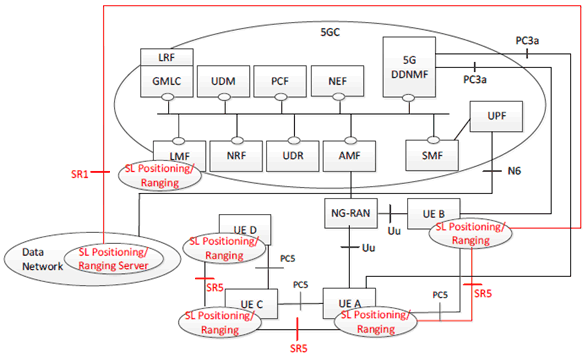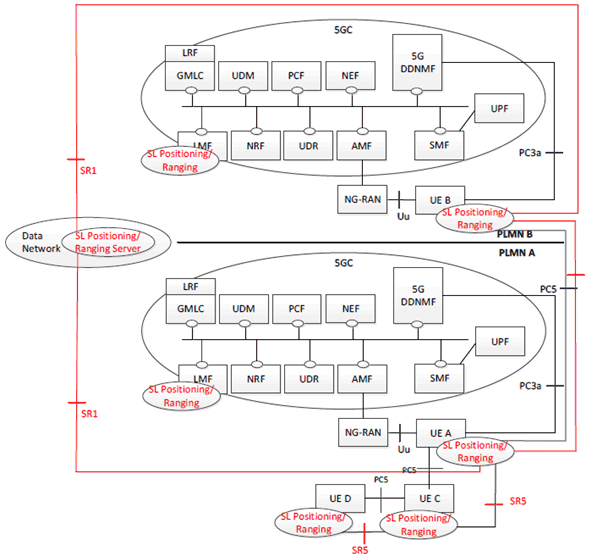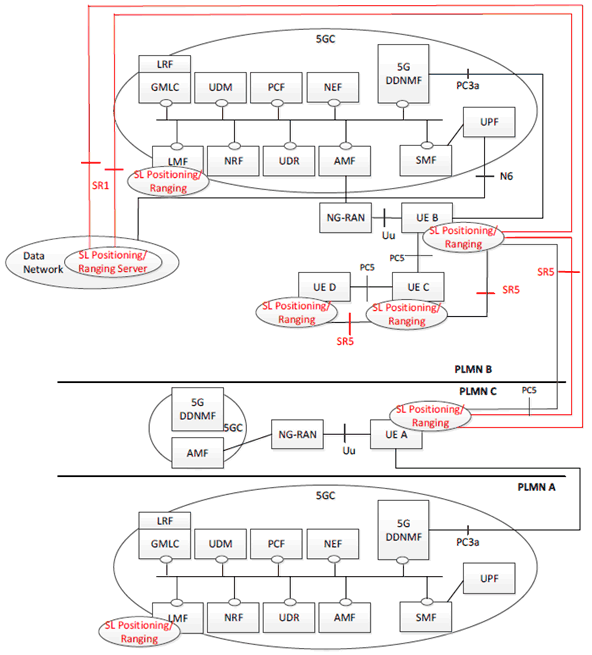Content for TR 23.700-86 Word version: 18.0.0
4 Architecture assumptions and requirements
4.1 Architecture assumptions
4.2 Architecture requirements
4.3 General reference architecture
...
...
4 Architecture assumptions and requirements p. 12
4.1 Architecture assumptions p. 12
- Ranging-based services and sidelink positioning consists of distance measurement, direction measurement, or both. UE is allowed to request the distance measurement only, direction measurement only, or both in the service.
- Not all UEs are assumed to be Ranging/Sidelink positioning capable. It is assumed that all Ranging/SL positioning capable UEs are ProSe or V2X capable.
- For direct communication/discovery related aspects, architecture defined in TS 23.287 and TS 23.304 is used as the basis, and the solutions defined for V2X and ProSe will be reused as much as possible.
-
Licensed, unlicensed and ITS spectrum may be used for PC5. If licensed spectrum is used, it shall be fully under operator control:
- For commercial ranging based service, both licensed and unlicensed spectrum can be used for PC5.
- For V2X service, licensed, unlicensed and ITS spectrum can be used for PC5.
- For Public safety service, licensed spectrum is used for PC5.
- Privacy protection and other security aspects will be tasked to SA3, and the related impact to architecture enhancement will be based on SA3 conclusion.
4.2 Architecture requirements p. 13
The enhancement to 5GC architecture shall be able to support Ranging-based services and sidelink positioning in in-coverage, partial coverage and out of network coverage scenarios as defined in TS 22.261 and TR 38.845:
- When the UE operates a use case having the corresponding positioning requirements, the requirements should be fulfilled when the UE is inside the network coverage as well as when it is outside the network coverage.
- support energy efficient UE ranging operation.
- support for a UE to discover other UEs supporting ranging.
- provide mechanisms for a MNO, or authorized 3rd party, to provision and manage ranging operation and configurations.
- support mechanisms for a UE to assist another UE to perform ranging of a third UE.
- It cannot be assumed that all ranging UEs support the same application for exchange of information.
- allow ranging service between 2 UEs triggered by and exposed to a SL Positioning Client UE.
- allow ranging service between 2 UEs triggered by and exposed to the application server.
- support one UE initiating ranging to the other UE.
- support ranging between UEs belonging to different PLMNs.
- allow roaming UEs to perform ranging.
- support relative position between UEs supporting V2X application.
4.3 General reference architecture p. 13
4.3.1 General p. 13
Figure 4.3.1-1 shows a reference architecture for Sidelink Positioning and Ranging-based services for non-roaming operation. In this case, the UE A and UE B that are involved in Sidelink Positioning and Ranging-based services have subscription from the same PLMN. The reference architecture also supports the case that UE-A or UE-B or both are not registered to the network or not in coverage. UE C and UE D may be out of coverage, or with partial network coverage. For simplicity, this Figure only shows target UE and reference UE (i.e. UE-A, UE-B, UE-C and UE-D), and there could also be Assistant UE, Located UE and SL Positioning Server UE in the architecture as per the solution.

Figure 4.3.1-1: Reference architecture for Sidelink Positioning and Ranging-based services for non-roaming and same PLMN operation
(⇒ copy of original 3GPP image)
(⇒ copy of original 3GPP image)
Figure 4.3.1-2 shows a reference architecture for Sidelink Positioning and Ranging-based services for Inter-PLMN non-roaming operation. In this case, the UE A and UE B have subscriptions from different PLMNs, i.e. PLMN-A and PLMN-B respectively. UE C and UE D may be out of coverage, or with partial network coverage. For simplicity, this Figure only shows target UE and reference UE (i.e. UE-A, UE-B, UE-C and UE-D), and there could also be Assistant UE, Located UE and SL Positioning Server UE in the architecture as per the solution.

Figure 4.3.1-2: Reference architecture for Sidelink Positioning and Ranging-based services for inter-PLMN operations
(⇒ copy of original 3GPP image)
(⇒ copy of original 3GPP image)
Figure 4.3.1-3 shows a reference architecture for Sidelink Positioning and Ranging-based services for Inter-PLMN non-roaming operation. In this case, the UE A and UE B have subscriptions from different PLMNs, i.e. PLMN-A and PLMN-B respectively. In addition, UE A is roaming and registered to PLMN-C. UE C and UE D may be out of coverage, or with partial network coverage. For simplicity, this Figure only shows target UE and reference UE (i.e. UE-A, UE-B, UE-C and UE-D), and there could also be Assistant UE, Located UE and SL Positioning Server UE in the architecture as per the solution.

Figure 4.3.1-3: Reference architecture for Sidelink Positioning and Ranging-based services for inter-PLMN operation with roaming
(⇒ copy of original 3GPP image)
(⇒ copy of original 3GPP image)
4.3.2 Functional descriptions p. 16
Sidelink Positioning and Ranging-based services are supported based on the architectures in clause 4.3.1, with the following reference points:
- SR1: The reference point between the UE Sidelink (SL) Positioning and Ranging function in the UE and the SL Positioning/Ranging Server. This reference point is out of scope of this specification. It may be used for the configuration and application layer signaling.
- SR5: The reference point between the Sidelink (SL) Positioning and Ranging function in UEs. It is carried over the PC5 reference point.
- Whether SR5 will be over PC5-RRC, PC5-D, PC5-U and/or PC5-S will be aligned with RAN WGs.
-
PC5: The reference point between the UEs. It also supports the Sidelink Positioning and Ranging operation defined by RAN WGs.
- N1: In addition to the relevant function defined in TS 23.501, if the UE is in coverage, it may be also used to convey the SL Positioning and Ranging policy (SLPRP) (including service authorization) from AMF to the UE, and to convey the UE's capability from the UE to the AMF. If the LMF supports Sidelink Positioning and Ranging-base services, it may be also used to carry the signaling between UE and LMF, as defined in TS 23.273.
- N2: In addition to the relevant functions defined in TS 23.501 for N2, in the case of SL Positioning and Ranging-based service is supported by NG-RAN, it is also used to convey the SLPRP policy and parameters (including service authorization) from AMF to NG-RAN.
- Uu: The reference point between the UE and the NG-RAN.
Nlmf:
In addition to the relevant services defined in TS 23.273, if the LMF support SL Positioning and Ranging-based service, it may be used to provide service to other NFs related to it.
Nudm:
In addition to the relevant services defined in TS 23.501 for Nudm, in the case of SL Positioning and Ranging-based service, services provided by UDM are used to get the related subscription information to AMF during Initial registration procedure or UE Configuration Update (UCU) procedure to inform AMF subscription information has changed.
Npcf:
In addition to the relevant services defined in TS 23.501 for Npcf, in the case of SL Positioning and Ranging-based service, services provided by H-PCF are used to provide SL Positioning and Ranging Service related parameters to V-PCF for UE and NG-RAN in the roaming case.
Nudr:
In addition to the relevant services defined in TS 23.501 for Nudr, in the case of SL Positioning and Ranging-based service, services provided by UDR are used to notify the PCF and the UDM of the update of the SL Positioning and Ranging-based service related information.
Namf:
In addition to the relevant services defined in TS 23.501 for Namf, in the case of SL Positioning and Ranging-based service, services provided by AMF are consumed by PCF to provide the SL Positioning and Ranging-based service related parameters for the UE and the NG-RAN to AMF, and to enable the AMF create or update UE context related to SL Positioning and Ranging-based service.